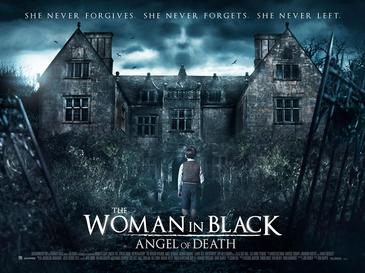
The year is 1940, forty years after the events of the first film. Teacher Eve Parkins (Phoebe Fox) is spending a night on an Underground platform with a group of children and headmistress Jean Hogg (the excellent Helen McCrory). Not surprisingly, given the amount of Nazi high explosive about, the group are about to be evacuated to a site on the East coast. Yes, it's Eel Marsh House, empty for generations. Oo-er.
On the way to their supposed sanctuary from terror the group encounter a jolly nice chap, RAF Flying Officer Harry Burnstow (Jeremy Irvine), who is being posted to an airfield near Crythin Gifford, the town inland from Eel Marsh. He and Eve hit it off. The party is greeted at the town by a surly doctor (Adrian Rawlins), and find that the house is in a parlous state, with dodgy floors and a general air of decay.
It soon becomes clear that the ghost is still around and she is focusing on a recently-orphaned lad called Edward. Sadly, the film uses the now hackneyed method of revealing spookiness by having a child who can't speak do eerie drawings and scrawl cryptic messages to adults. Thus Eve is told 'You let them take him'. She has a dark secret! It involved a child! Harry visits, then we see him having some kind of anxiety attack going back over the causeway. He has a dark secret too! 4
Then children start dying. The logical thing to do - after some fairly familiar jump-scare antics - is to simply get away from a bloody dangerous place. Harry duly returns and takes the party to his RAF base, whereupon we get a genuinely interesting plot twist as Harry's secret is revealed. This is, for me, the best bit of the film, and I'm not putting a spoiler here. Suffice to say some genuine WW2 history is involved, along with the 'stiff upper lip' assumptions of the day.
The supposed place of refuge is nothing of the sort, of course, and the Woman duly turns up to claim another victim. There is a finale on the causeway which is nicely done, and not overlong, followed by the inevitable postscript that reveals, yes, that the ghost has not been exorcised. Maybe it is a franchise in the making.
Overall, viewers haven't rated this one too highly, perhaps because it lacks effective or original scares and the plot is uninspired. It's a typical 21st century horror movie, in fact, rather than a powerful ghostly tale. (And it certainly doesn't help that the setting and use of child actors invites comparison with two first-rate Spanish movies, The Devil's Backbone and The Orphanage.)
There's nothing outstanding about this one, but it passes the time.



3 comments:
I have seen the first WOMAN IN BLACK film, and what could have been a fine return to the classic English/British ghost story was ruined by hackneyed ''jump-scares'' and ''scare-chords'' that swerve it into typical fodder. The casting of Daniel Radcliffe as the main character, I think, does not help matters, too. Overall, I felt is was a decent yet otherwise contrived and unsuccessful attempt. The sequel, too, does not look any better; but that is the problem with standard ghosts -- the author does not bother to add some creativity to his spook in the manner that M.R. James did.
Exactly. One longs for a moment like that in 'The Diary of Mr Poynter', when a character reaches down to stroke an old dog and then realises that the hairy head beside their chair belongs to something else entirely.
You said it! The second one called for a scene in James' story Martin's Close where the boy see's Ann Clarke emerging from the lake. That scene is a perfect moment in fear.
Post a Comment